The information provided within the linked video is a short glimpse and narration to the story of an abandoned bike in the Seventh-Ward and St. Roch borders of New Orleans. The introduction of the video is intended to provide a general context of the location of where the story will be held and where it falls within my portion of the MyNola Section Line. Our story begins just off the side of N. Claiborne Ave near Hunter’s Field. I chose this specific location as it has one of the largest amounts of abandoned property lots and is the main separation point of the two sections of 6th and 7th-ward. The interstate running above the location has created a very intimidating environment especially for a space that students of the Neo Jazz School have to move through. The story revolves around the bike and the student as the bike is immediately seen as a sentimental value to the student. The fact that there are two markets near this section of the city as well is another strengthening factor to the importance of bikes as they are popularly ridden around the market’s locations. Because of this, there are several local bike shops surrounding this location making a perfect destination for the student as this bike, in particular, is missing a pedal. The trip to the bike shop moves across town and allows for the audience to understand the difficulties and rough patches the student must pass just to make it to his destination. These difficulties include congested traffic, unsafe bikeways, blighted properties, and dysfunctional landscapes. This trip allows for the student to see a much larger aspect of the neighborhood that he lives in and expresses his imaginative ideas as to what aspects could be implemented into these spaces. The student eventually makes it to his destination just in time to get the bike fixed and join a group of bikers on their way to the market.
New Orleans: Climate Change and Child Correlation
What’s At Hand & The Most Recent Catastrophe
 The current and even predicted climate changes within the borders of New Orleans have slowly become a new normal for the city. Whether you believe the changes are due to human interaction or not, the effects have become undeniable. If no action is taken against these detrimental effects, then the city could quite possibly be washed away by 2050. The fourth to make landfall and most recent storm to hit Louisiana, Hurricane Berry, established an entirely new threat to the City of New Orleans. This is not because it contained conditions never seen in previous storms, but because of the preexisting circumstances surrounding the city.
The current and even predicted climate changes within the borders of New Orleans have slowly become a new normal for the city. Whether you believe the changes are due to human interaction or not, the effects have become undeniable. If no action is taken against these detrimental effects, then the city could quite possibly be washed away by 2050. The fourth to make landfall and most recent storm to hit Louisiana, Hurricane Berry, established an entirely new threat to the City of New Orleans. This is not because it contained conditions never seen in previous storms, but because of the preexisting circumstances surrounding the city.
Today Vs. Tomorrow?
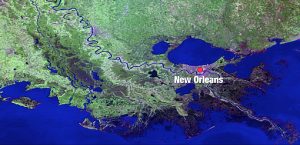
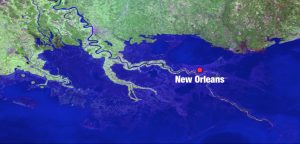
Cause & Effect
Increasingly vast amounts of snowmelt within the Great Plains followed by above-normal rainfall has led to an increase in height to the Mississippi River. Following this, at least 70 percent of the coastal salt marshes that protect New Orleans from the impact of storms could easily be emerged by rising sea levels. Let alone, there is still the fact of many portions within the city being eight feet below sea level. All of these factors come into even more extreme accounts once a storm begins to develop near the city simply because it is now nowhere near as tolerable to future storm detriments. Before we dive into what the youth have to offer and have already contributed to these issues, I would like to brief on what has already been implemented.
What’s Currently Being Done To Help?
The largest implication for the city’s coast has been The Coastal Protection and Restoration Authority. This program articulates clear and concise statements of priorities necessary for reconstructing the coast of Louisiana. Up to the present day, CPRA has developed a 2012, 2017, and 2023 coastal master plan along with a yearly annual plan. Each plan carefully produces a new strategy for preserving the coast which includes creating marshes, flood-proofing buildings, restoring shoreline ridges, and more. Looking specifically within the borders of New Orleans; Hydraulic Restoration, Sediment Diversion, and Structural Protection have all been main implications added by the CPRA.
Now that we have a better understanding of what is being done on a larger scale, let’s look a bit deeper as to how much is being done on a small scale.
Community Engagement: All Ages
![]()
This past June within the town of Seventh Ward, New Orleans several children of the community had noticed portions of their elementary playground was flooding. This was then brought up to their parents wondering if there were solutions to the issue at hand. Thus brought forth the creation of a community-driven organization called Healthy Community Services. The organization alleviates flooding as a neighborhood to provide locals the chance to make a small difference in their environmental status and to become apart of something. Not only does this give back to the community but it teaches all ages about bioswales, rain gardens, urban stall water flooding, coastal land loss, sea-level rise, and more.
To learn more about Healthy Community Services visit; https://www.hcsnola.org/
More Must Be Done!
As good as this may sound, it is really the only organization within the city limits of New Orleans working against climate change that has had true involvement with children. Although, it was the children who brought up the idea of the rain garden after learning about them in class. It seems as if the issues of climate change and it’s solutions have been expressed within the classroom, but not much has been offered for them to easily partake in outside of the classroom. About the only other involvement in the fight against it was the meager group of students who had gathered a few blocks from Lusher Middle – High School to protest the urgency to stop climate change. There are too many many young individuals who know of the issues but don’t have the right kind of accessibility to help, there is too much opportunity at hand.
Sources:
https://wattsupwiththat.com/2019/07/12/the-battle-of-new-orleans-climate-change-edition/https://www.markey.senate.gov/GlobalWarming/impactzones/neworleans.htmlhttps://neworleanscitybusiness.com/blog/2019/09/10/louisiana-official-state-adapting-to-new-normal-of-climate-change/https://www.vice.com/en_us/article/bjvb84/new-orleans-has-to-work-fast-to-avoid-washing-away-by-2050https://en.wikipedia.org/wiki/Hurricane_Barry_(2019)https://coastal.la.gov/http://www.pbs.org/wnet/peril-and-promise/2019/06/new-orleans-backyard-flooding-gardens/https://www.desmogblog.com/2019/03/15/new-orleans-student-global-climate-strike-schools
New Orleans: Population Statistics and Child Oriented Cities
Percentages of Different Race Within the City
 It doesn’t take too much digging to discover the conditions of how children are living within the city borders of New Orleans. It immediately becomes prominent if one were to look at the statistics. The city itself is currently at a population of about 423,656. It has been scientifically proven that detrimental environments and increased trauma within the earlier stages of a child’s life can cause a large set back in the child’s brain development. Between 2000 and 2010, the metro area lost 22 percent of children under 18 compared to only seven percent of all adults. Now, of course, this study spaced throughout the timeline of Hurricane Katrina and it’s the horrific impact on the city. But what can this say about any up and coming storms that could be even more horrific given the worse existing conditions due to climate change? Specific parishes that were affected the most traumatically were Orleans, Plaquemines, and Jefferson, experiencing greater losses among children than among adults. Now, moving on to the more recent statistics…
It doesn’t take too much digging to discover the conditions of how children are living within the city borders of New Orleans. It immediately becomes prominent if one were to look at the statistics. The city itself is currently at a population of about 423,656. It has been scientifically proven that detrimental environments and increased trauma within the earlier stages of a child’s life can cause a large set back in the child’s brain development. Between 2000 and 2010, the metro area lost 22 percent of children under 18 compared to only seven percent of all adults. Now, of course, this study spaced throughout the timeline of Hurricane Katrina and it’s the horrific impact on the city. But what can this say about any up and coming storms that could be even more horrific given the worse existing conditions due to climate change? Specific parishes that were affected the most traumatically were Orleans, Plaquemines, and Jefferson, experiencing greater losses among children than among adults. Now, moving on to the more recent statistics…
2018
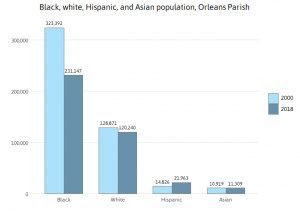
The Dynamics Between Parents, Children, and Poverty
In the city of New Orleans, the share of adults with less than a high school degree fell from 25 percent to 14 percent but is still higher than the U.S. average of 12 percent. What does this mean within our research? The higher the educational attainment, the higher the income and internet access. Although most New Orleans parents are in the workforce, low-wage jobs are still much too prevalent to provide proper support towards a child. The child poverty rate in New Orleans is statistically unchanged from 1999. In Jefferson Parish, the child poverty rate jumped from 20 percent in 1999 to 28 percent in 2017 — greatly surpassing the U.S. child poverty rate, which rose from 17 to 18 percent between 1999 and 2017.
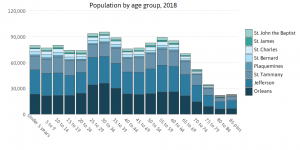
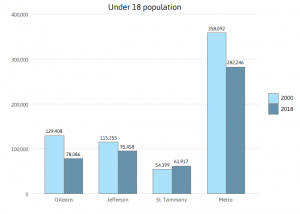


The share of households with children is shrinking while the share of individuals living alone is growing — both across the metro and nation. As of 2017, 24 percent of households in metro New Orleans included children, down from 34 percent in 2000. The metro had 358,092 children under 18 years in 2000 and only 282,246 in 2018. Much of this loss was driven by Orleans Parish, where the under 18 population declined to 78,086 from 129,408. The under 18 population is now 22 percent of the metro population, down from 27 percent in 2000.
Where To Go From Here
38 percent of our children below the age of 18 live in poverty. That is 10 points higher than the rest of Louisiana and twice the 19 percent national child poverty rate. So what can be done?
Access to adequate health care and education as well as public safety and infrastructure must be provided. The city also must provide systems for dealing with blight (plant disease) and regulating zoning decisions to make sure housing is available for a fair price and that neighborhoods are safe and livable. On top of this, small organizations like I had mentioned in the previous article can make a massive impact on viable living. Climate change is taking properties and making the situation much more difficult. For the city to continue to come together and create better management practices, huge impacts can be made.
Sources:
https://www.datacenterresearch.org/data-resources/who-lives-in-new-orleans-now/
https://www.nola.com/opinions/article_0fc48978-a57e-55d8-a656-05ea53586635.html